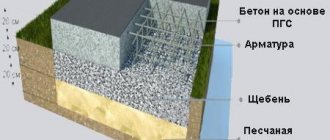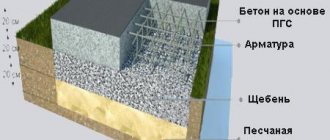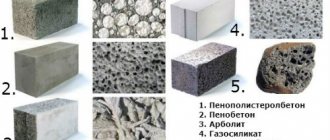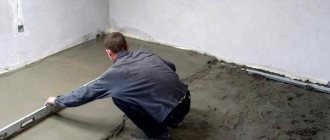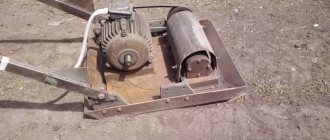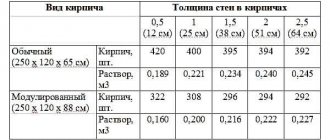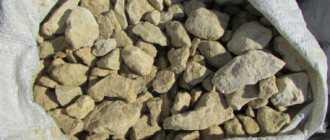When constructing foundations, blind areas, bases for paths and roads, sidewalks and laying communications, various combinations of soil, sand, crushed stone, gravel and secondary gravel are used. In this case, the mixtures are necessarily compacted and compacted, which implies a certain compaction coefficient, which must be known to accurately calculate the material.
Typical preparation of the base for a monolithic or block foundation in section
On average, data on the compaction coefficients of the most popular materials is presented in Table 1.
| Material and its technical characteristics | Compaction factor |
| Crushed stone fraction 40-70, grade 800 fraction 70-120, grade 800 all fractions, grade 300…600 | Average 1.1 1,25…1,3 1,25…1,3 1,1…1,5 |
| Slag, depending on density | 1,3…1,5 |
| Construction sand | 1,15 |
| Soil, depending on type | 1,1…1,4 |
| PGS | 1,2 |
| Expanded clay | 1,15 |
However, these are general, average data. Let's take a closer look at where the concept of compaction coefficient comes from and how to determine it.
Why compact the soil?
To understand the scale of the problem, you need to understand the importance of soil compaction. Since soil is not a building material, we involuntarily stop taking it into account during the construction process. The soil is subject to subsidence, shrinkage, subsidence, swelling and other processes that can cause deformation of the base and harm the entire house.
- Settlement is the process of soil compaction under the weight of a building. The main task of compaction is to make the settlement uniform so that it occurs within the design values.
- Subsidence is another type of compaction when the soil loses its volume due to soaking or rotting of organic matter.
- Shrinkage occurs as a result of temperature influences.
- Swelling is an increase in soil volume due to saturation of the soil with groundwater.
All these processes are equally affected by proper compaction.
Factors determining density
The bulk weight of sand depends on several factors:
- The fraction and shape of sand grains determines the density of the bulk material to a greater extent. The larger the fragments, the greater the distance between them and vice versa. Round and square grains of sand take up more space than flat ones.
- Breed of origin. The denser the mineral from which the sand is formed, the greater the mass.
- Remains of soil and organic impurities also affect the bulk mass of sand. The technology for preparing mortars involves the use of purified fine filler, so this parameter can be adjusted by washing or sifting the embankment.
- Humidity after washing or sand mining. Water penetrates the pores of sand grains and increases their weight. The bulk density of dry sand is up to 30% less than wet sand. As it dries, the mass decreases and the volume increases.
- Sand compacted during placement has a much higher density per unit volume than sand poured in its normal state.
The value of mass per cubic meter can be clearly seen in the table of bulk density of natural sand:
| Sand condition | Density value, kg/m 3 |
| Normally dry | 1200…1700 (depending on the type of rock and fraction) |
| Quartz | 1400 |
| Dry fluffy | 1440 |
| River | 1600 |
| Dry compacted | 1680 |
| Wet | 1920 |
| Wet compacted | 2080 |
Local soil is not compacted
This mistake is made when not imported sand is used under the foundation or backfill, but soil that was extracted when digging a pit or trench. People often assume that their native soil is already compacted, so they believe that if they walk on it or drive a tractor several times, it will reach the required density. In fact, this idea is a construction myth.
When a pit or trench is prepared, part of the soil is removed from it, violating the integrity of the soil. Over the long history of the earth, the soil on our site has become compacted, but when digging, it becomes less compacted. If the native soil is returned to backfill or as a cushion under the foundation, then its density turns out to be lower than that of the surrounding soil.
Completing the negative picture is the filtration coefficient, which reflects the rate at which moisture passes through the soil. Water tends to penetrate into the zone with the lowest filtration coefficient, so we get a layer of subsidence soil under the blind area or house.
Filtration coefficient for different types of soil
24-hour sale of sand, crushed stone, concrete with delivery.
Asphalt crumbs
Construction services
Site search
- Center for Foreign Languages 01/18/2017
- Soundproofing materials 05/16/2016
- Restoration of old garden paths 04/17/2016
- Warm self-leveling floor. 04/05/2016
- Stair mounting beam 03/09/2016
- Should I lay laminate or linoleum on the floor? 02/26/2016
- Vegetable garden in postmodern style 02/07/2016
- Methods for leveling floors. 02/02/2016
- How to make a warm wooden floor 01/28/2016
- Crushed stone and sand in construction 01/23/2016
- Granite crushed stone 01/22/2016
- Construction of highways 12/23/2015
- Slab foundation 12/21/2015
- Use of granite crushed stone in the construction of foundations 12/15/2015
- Construction of a foundation for building a house in a swampy area 12/15/2015
- Areas of application of peat 09.12.2015
- Repair of a concrete blind area and its installation is the work of the owner 12/08/2015
- Rent a vibrating plate in Solnechnogorsk 12/02/2015
- Crushed stone and gravel 11/08/2015
- Crushed stone and sand in construction 07.11.2015
- Soils and fertilizers 05.15.2015
- PGS and OPGS difference 05/02/2015
- Flakiness of crushed stone, what is it? 04/23/2015
- Earth soil for planting beds 04/19/2015
- Soil to raise the level of the site. 04/14/2015
- Horse manure 04/11/2015
- What kind of sand is needed for concrete? 04/06/2015
- Krasnogorsk 03/28/2015
- Which sand is best for the garden 03/24/2015
- Sand in Khimki 03/20/2015
No specialized equipment is used
It is not enough to simply walk on the ground to compact the soil. This requires the use of specialized tools or equipment.
- A manual tamper can be made on your own. A heavy log, beam or steel pipe with a flat square base is suitable for these purposes. With a hand tamper you need to hit the ground at right angles. The speed of working with such a tool is low, so manual tamping is used in small areas. For example, to compact the soil for laying paving slabs on the site.
- Vibrating plate (vibrating platform) - has a massive sole that transmits vibrations to the ground. Typically, this equipment is rented during construction. The slabs vary depending on their weight. The greater the weight, the larger the compacted layer. In private construction, a slab from 75 to 90 kg is sufficient; it allows compacting layers up to 25 cm thick. The base area varies from 1600 to 6000 sq. cm.
- A vibrating foot (vibrating rammer) has less strength and works on a different principle. The equipment makes peculiar “jumps”, compacting the soil. At the same time, the impact area of the vibroleg is smaller (1000 cm2), and the depth of compaction is higher (from 40 cm with a weight of 60 – 70 kg).
- The roller is used in road construction; heavy equipment is practically not used in private construction.
Since such equipment is rented, you need to name it correctly; this can sometimes be difficult due to the large number of names. For example, a vibrating platform is usually called a slab, and a vibrating rammer is a leg, and builders sometimes call a leg a slap-leg. The leg is suitable for narrow trenches, the slab is used for compacting the cushion under the foundation.
Technical types of building mixtures
ASG is a mixture of sand and gravel. Used for construction work. The composition of the mixture is regulated by GOST 23735-2014.
ShchPS is a mixture of crushed stone, gravel, and naturally mined sand. Produced according to GOST 25607-2009.
ShchPS from crushed concrete - are manufactured according to the technical regulations of GOST 32495-2013.
When assessing the quality of mixtures, the following are taken into account:
- general indicators of the composite material;
- properties of sand;
- properties of crushed stone, gravel.
Bulk materials are checked for density, strength, dust and debris content, and inclusions of hazardous substances.
Origin and routes of production of building mixtures
Sand-gravel mixtures are extracted from gravel-sand, boulder-gravel-sand rocks.
The ASG includes:
- sand with a particle size of 0.05–5 mm;
- gravel 5–70 mm;
- boulders over 70 mm.
The presence of gravel ranges from 10-90% of the total mass.
Two types of sand and gravel mixture are produced:
- natural mixture extracted and supplied without processing;
- the enriched mixture is extracted naturally, enriched by adding or extracting the sand and gravel component.
ASG is extracted from ravines, lakes and seas. Marine material is the purest. The rest may contain impurities from clay, limestone, and litter.
The composition of ACHPS of natural origin includes crushed stone of the main (40–80 mm, 80–120 mm) and proppant fraction (5–20 mm, 5–40 mm).
The crushability of crushed stone from sedimentary rocks, as well as crushed stone from igneous rocks, is graded 400 and 600, respectively.
ShchPS made of crushed concrete and reinforced concrete includes:
- inorganic crushed stone shot with a particle size of 5 mm or more;
- inorganic sand obtained from crushed crushed concrete.
The materials are crushable residues from the destruction of concrete or reinforced concrete building structures.
Single layer seal
In this case, the entire volume of sand is immediately poured into the sinuses of the foundation or into the foundation pit, and then they try to level it. From the description of vibration technology, it becomes clear that it is capable of compacting only soil layers of a certain thickness. If we talk about manual compaction, the soil layer should be even thinner. The optimal values for mechanized processing are layers of 15–20 cm.
If you compact a layer of soil 40 cm thick, the vibrations will not pass through the entire layer. As a result, the foundation of the house will be located on a loose cushion.
Standard values
The sand compaction coefficient is the dependence of the mass characteristic of a certain volume of a control sample (otherwise known as density) to the accepted reference standard.
Laboratory studies make it possible to obtain standard density parameters; these characteristics form the basis of assessment work, the purpose of which is to determine the quality of the delivered order and its adherence to industry requirements. Regulatory documents that set out generally accepted reference frameworks are considered to be:
- GOST 8736-93,
- GOST 25100-95,
- GOST 7394-85,
- SNiP 2.05.02-85.
Additional information and restrictions are indicated in the design documentation. As can be seen from the table data, the compaction coefficient is within 0.95-0.98 of the standard value.
Crushed stone and crumbs cannot be compacted
This statement is a myth, because of which crushed stone and crumbs are not compacted at all. For these materials, compaction is also necessary. As compaction occurs, there is less air between the parts of the backfill. If we talk about aerated concrete chips, then the particles in it cling to each other with sharp edges. The result is a dense base.
Expanded clay is an exception; it really does not compact well due to the round shape of the granules, but it is rarely used as a base for critical structures.
Determination of Ku in laboratories or field conditions
Having in hand a project with a given compaction coefficient of ASG, sand or soil, it is necessary to determine whether the actual density of the base corresponds to the desired value. Various techniques are used for this.
Through sampling
This method is the most accurate, but not very fast. The participation of a laboratory is required, since it is difficult to create favorable conditions for measurements on construction sites.
For experiments, cutting rings of known volume are used. Without disturbing the structure of the material, samples are taken and further weighed.
The soil sampled at several points on the site is packed into a sealed container and sent for research. After receiving the weighing results, the dependence of soil density on moisture is determined and the actual compaction coefficient at each sampling point is calculated. After assessing the degree of soil preparation, a decision is made to continue or terminate soil compaction work.
Dynamic density meter (penetrometer)
The measurements are used as an express method to assess the degree of compaction of the base in the field. The dynamic density meter is a pointed steel rod with a handle and a striking pad. A load of a certain mass is movably attached to it.
The density meter is installed vertically on the base. The weight is then lifted and dropped onto the impact pad. In this case, the rod gradually sinks into the ground. The number of strikes is counted.
After the tip has completely descended below the surface, the compaction coefficient is determined using a special table. If it is less than required by the project, additional compaction is performed. If Ku corresponds to the desired value, the base is ready for further work.
Communication outlets are not sealed
Communications can enter the house through the foundation walls, then they are in the backfill compaction zone. Also, soil compaction above communications can be encountered when installing floors on the ground. In these places, using a vibrating plate is difficult because there is always a danger of damaging the pipe. Often because of this, they decide not to compact the soil in these places. It is still more correct to compact it; for this you can use a manual tamper.
Compacted soil should be not only above the communications, but also under them. Read more about errors associated with laying communications through the foundation in the article (link) .
Estimate accounting
The volume of materials for construction is entered into the estimate calculator, taking into account compaction. The coefficient of relative compaction and loosening (discharge coefficient) is applied.
The consumption of sand with the required compaction coefficient for backfilling from 0.9 to 1.0 is calculated taking into account the relative compaction coefficient from 1.0 to 1.1, respectively, for slag 1.13–1.47.
The relative compaction coefficient for rocks with a density of 1.9 – 2.2 g/cm3 is 0.85–0.95.
Features of using the double sensing method
Regarding soils characterized by heterogeneous moisture, the determination of dynamic density is carried out in two stages. The first is carried out as described above. When re-estimating the density, a base stamp is used. To do this, a circular recess with a diameter of 100 mm and a depth of 250 mm is made next to the primary hole. The stamp is placed strictly vertically on the bottom and the final compaction of the soil is carried out with at least 40 shock load cycles. Those layers of soil that end up in the stamp must be at least 50 mm in height. They are also additionally compacted in a similar way.
After leveling the soil located above the well, the stamp is removed and the volume taken by it is tested for density in the previously indicated way, using a special table given in the passport of the dynamic density meter.
What causes the level of the bulk mixture and the degree of compaction to change?
The sand passes through a tamper, not necessarily a special one, perhaps during the moving process. It is quite difficult to calculate the amount of material obtained at the output, taking into account all the variable indicators. For an accurate calculation, it is necessary to know all the effects and manipulations carried out with sand .
The final coefficient and degree of compaction depends on various factors:
- method of transportation, the more mechanical contact with irregularities, the stronger the compaction;
- route duration, information available to the consumer;
- presence of damage from mechanical influences;
- amount of impurities. In any case, foreign components in the sand give it more or less weight. The purer the sand, the closer the density value is to the reference value ;
- the amount of moisture that has entered.
Immediately after purchasing a batch of sand, it should be checked.
What samples are taken to determine the bulk density of sand for construction?
You need to take samples:
- for a batch of less than 350 tons – 10 samples;
- for a batch of 350-700 tons – 10-15 samples;
- when ordering above 700 tons - 20 samples.
Take the resulting samples to a research institution for examination and comparison of quality with regulatory documents.
